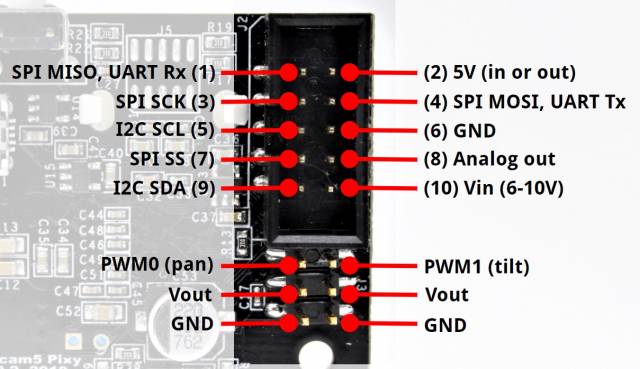Table of Contents
Powering Pixy2
You have some choices when powering Pixy2… always good to have choices! We expect that most Pixy2 users will either power Pixy2 through the USB cable/connector or though the Arduino cable (I/O connector). These two choices are the simplest, but here are all available power options:
- Power Pixy2 through the USB cable/connector (regulated 5V)
- Power Pixy2 through the I/O connector, pin 2 (regulated 5V)
- Power Pixy2 through the I/O connector, pin 10 (unregulated 6V to 10V)
Note: you can have both the Arduino cable and the USB cable plugged into Pixy2 simultaneously without any bad things happening. In fact, this is very useful when you want to do a quick check to see what Pixy2 sees through PixyMon, while Pixy2 is connected to your Arduino (in situ, so to speak).
For reference, Pixy2's typical power consumption is 140mA at 5V.
USB cable/connector
When you plug Pixy2 into your computer via USB cable, Pixy2 is powered through the regulated 5V provided by the USB port. It is also possible to power small RC servos through the USB cable (like the ones in the pan-tilt mechanism) as long as the USB cable is kept somewhat short (less than 4ft is best). The USB cable that came with your Pixy2 is recommended – it's higher-quality than most!
I/O connector
The I/O connector is marked “J2” on Pixy2's PCB. Pin 2 of the I/O connector can accept 5V for powering Pixy2. This is convenient when you want to power Pixy2 through the Arduino cable (ie, by hooking up the Arduino cable, your Arduino is powering Pixy2, assuming your Arduino is suitably powered.) Or you can make your own I/O cable for Pixy2 communication/power, but be careful! Pin 2 and the ground pin (pin 6) are not reverse-polarity protected. Get the power backwards and Pixy2 is a goner. For good!
Unregulated power
The I/O connector has an unregulated power input (Vin, pin 10). You can provide between 6V and 10V to this input and Pixy2's linear regulator will create the 5V power rail.
Powering Pixy through Vin (pin 10) can result in more current being available for the RC-servos to use with the pan-tilt unit. Connecting Pixy2 to an Arduino when Pixy2 is being powered through Vin results in Pixy2 sourcing the power for the Arduino. This is sometimes preferable to the Arduino sourcing power to Pixy2 because the voltage regulator on some Arduinos cannot handle the current requirements of Pixy and the pan-tilt unit (two RC-servos.)
Some additional notes:
- Vin (pin 10) of the I/O connector is reverse-polarity protected, so nothing bad will happen if you get things backwards.
- It is safe to connect Pixy2 to a computer via USB while Pixy2 is powered through Vin.
